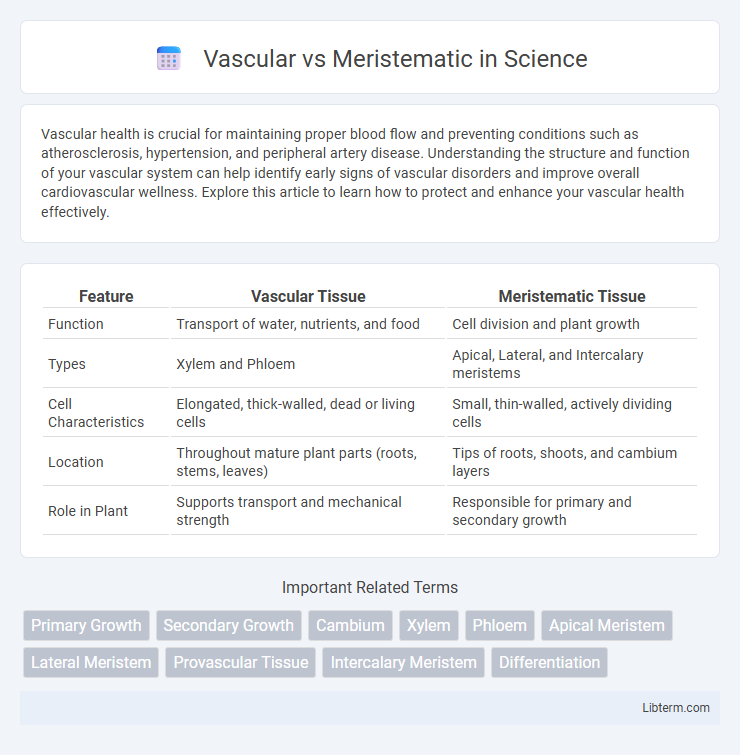Vascular health is crucial for maintaining proper blood flow and preventing conditions such as atherosclerosis, hypertension, and peripheral artery disease. Understanding the structure and function of your vascular system can help identify early signs of vascular disorders and improve overall cardiovascular wellness. Explore this article to learn how to protect and enhance your vascular health effectively.
Table of Comparison
| Feature | Vascular Tissue | Meristematic Tissue |
|---|---|---|
| Function | Transport of water, nutrients, and food | Cell division and plant growth |
| Types | Xylem and Phloem | Apical, Lateral, and Intercalary meristems |
| Cell Characteristics | Elongated, thick-walled, dead or living cells | Small, thin-walled, actively dividing cells |
| Location | Throughout mature plant parts (roots, stems, leaves) | Tips of roots, shoots, and cambium layers |
| Role in Plant | Supports transport and mechanical strength | Responsible for primary and secondary growth |
Introduction to Plant Tissue Types
Vascular tissue, consisting of xylem and phloem, specializes in the transport of water, nutrients, and sugars throughout the plant, enabling essential physiological functions. Meristematic tissue comprises undifferentiated cells responsible for plant growth, found in regions such as apical and lateral meristems where continuous cell division occurs. Understanding these primary plant tissue types reveals their distinct roles in supporting structural integrity and promoting development in vascular plants.
Overview of Meristematic Tissues
Meristematic tissues consist of undifferentiated, actively dividing cells responsible for plant growth, primarily found in regions like apical, lateral, and intercalary meristems. These tissues contribute to primary and secondary growth by producing new cells that differentiate into various specialized tissues, unlike vascular tissues that are involved in transport. Meristems maintain a high mitotic activity essential for the continuous development of shoots, roots, and vascular systems in plants.
Characteristics of Vascular Tissues
Vascular tissues, including xylem and phloem, are specialized for the transport of water, minerals, and nutrients across plants, exhibiting elongated cells with thickened walls for structural support. These tissues are lignified, providing rigidity and enabling efficient conduction over long distances compared to meristematic tissues, which consist of undifferentiated, actively dividing cells responsible for growth. Vascular tissues are organized into continuous strands forming vascular bundles, distinguishing them functionally and anatomically from the localized, mitotically active meristematic regions.
Key Differences Between Meristematic and Vascular Tissues
Meristematic tissues consist of undifferentiated cells responsible for plant growth, actively dividing to form new organs, whereas vascular tissues are specialized for transport, consisting mainly of xylem and phloem. Meristematic cells are small, densely packed with thin walls, and have prominent nuclei, while vascular tissues contain differentiated cells such as vessel elements and sieve tubes that facilitate water, nutrient, and food conduction. The key difference lies in their function: meristematic tissue drives growth and organ formation, whereas vascular tissue ensures distribution of essential substances throughout the plant.
Functions of Meristematic Tissue in Plant Growth
Meristematic tissue plays a crucial role in plant growth by providing regions of continuous cell division, enabling the formation of new organs such as roots, stems, and leaves. Unlike vascular tissue, which is responsible for the transport of water, nutrients, and food, meristematic cells are undifferentiated and contribute to primary and secondary growth through apical and lateral meristems. This tissue drives elongation and increases girth, ensuring overall development and repair of plant structures.
Role of Vascular Tissue in Transport
Vascular tissue in plants, comprising xylem and phloem, plays a critical role in transporting water, minerals, and nutrients throughout the organism. Xylem primarily conducts water and dissolved minerals from roots to leaves, while phloem distributes organic compounds like sugars from photosynthetic sites to non-photosynthetic tissues. This transport system supports growth, nutrient allocation, and overall plant vitality, distinguishing it from meristematic tissue, which is primarily responsible for cell division and growth.
Cellular Structure Comparison
Vascular tissues, composed of xylem and phloem, have specialized elongated cells such as tracheids and sieve tube elements adapted for efficient transport of water, nutrients, and food throughout the plant. Meristematic tissues consist of small, densely packed, isodiametric cells with thin primary cell walls, high nucleus-to-cytoplasm ratio, and actively dividing capabilities to facilitate plant growth. Unlike the differentiated vascular cells, meristematic cells remain undifferentiated and lack extensive secondary cell wall thickening, enabling continuous cell division and differentiation.
Locations in Plants: Meristematic vs Vascular
Meristematic tissues are primarily located at the tips of roots and shoots, including apical and lateral meristems, where they facilitate plant growth through cell division. Vascular tissues, consisting of xylem and phloem, are situated throughout the plant in stems, roots, and leaves, enabling the transport of water, nutrients, and food. The strategic distribution of meristematic and vascular tissues supports both developmental growth and resource allocation crucial for plant survival.
Importance in Plant Development
Vascular tissues, consisting of xylem and phloem, are crucial for transporting water, nutrients, and sugars, enabling efficient resource distribution and structural support, thus facilitating plant growth and development. Meristematic tissues, found in root and shoot apices, are responsible for continuous cell division, producing new cells that contribute to organ formation and plant elongation. The interplay between vascular and meristematic tissues ensures both expansion and the functional integration of plant systems essential for survival and reproduction.
Applications in Plant Biotechnology
Vascular tissues, including xylem and phloem, are crucial for the efficient transport of water, nutrients, and signaling molecules, making them essential targets in plant biotechnology for improving crop resilience and nutrient use efficiency. Meristematic tissues, composed of undifferentiated cells with high division potential, are fundamental in tissue culture and genetic engineering for clonal propagation and genetic modification. Leveraging vascular tissue engineering enhances grafting techniques and stress tolerance, while meristematic cell manipulation accelerates the development of disease-resistant and high-yielding plant varieties.
Vascular Infographic

 libterm.com
libterm.com